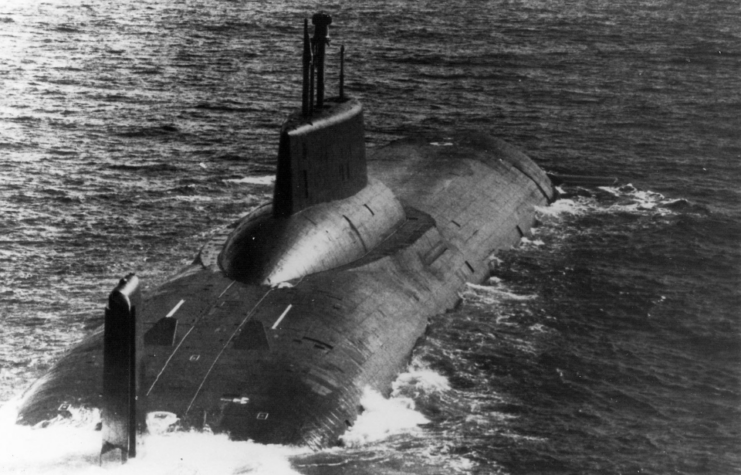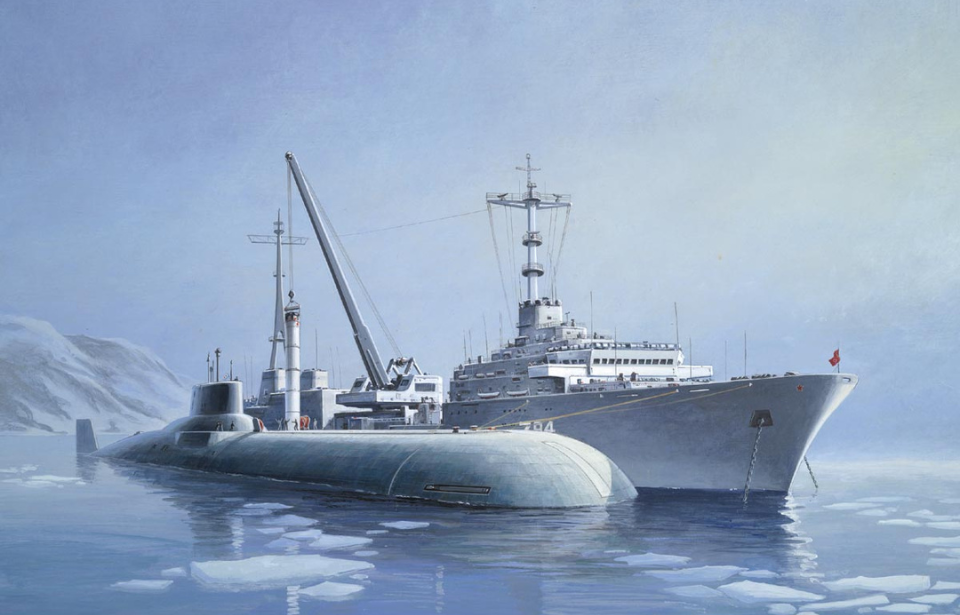The Typhoon-class – also known as Project 941 Akula – were six Soviet nuclear-powered ballistic missile submarines. The largest ever constructed, they served with the Soviet and Russian navies both before and after the Cold War. Unlike the majority of their counterparts, these vessels were active for decades, with the last being decommissioned on February 6, 2023.
Design of the Typhoon-class submarines

The Typhoon-class were the largest submarines ever constructed, with a length of 574.2 feet, a beam of 75.6 feet and a draught of 39.4 feet. Their immense length became evident underwater, with the vessels displacing 48,000 tons when submerged.
Along with their size made them distinctive among other Soviet submersibles, their designations did, as well. Typically, Soviet or Russian submarines are identified with the letter “K,” for cruiser (Крейсер), followed by a number. For instance, K-19 was the lead boat in the Hotel-class. However, the Typhoon-class’ large size meant the vessels were classified as heavy cruisers (Тяжелый Крейсер), with the identification “TK.”
Typhoon-class submarines boasted five inner hulls, which made survivability far more likely in the event of an attack or accident. If one became compromised, the vessel could still be operated from another. Two escape capsules were located on either side of the conning tower, and they could be used if the hulls became compromised.
The Typhoon-class was powered by two OK-650 pressurized-water nuclear reactors, two geared steam turbines and two shafts with seven-bladed shrouded screws. They had a surfaced speed of nearly 25.6 MPH, with the ability to travel at 31 MPH when submerged. With their 160-man crew, the vessels could remain submerged for upwards of 120 days.
Equipped with missiles and torpedoes

The Typhoon-class featured a main armament of 20 RSM-52 submarine-launched ballistic missiles (SLBM). With a three-stage solid-fuel rocket, the missiles had an operational range of 5,200 miles, with a payload of 10 multiple independently targetable reentry vehicle (MIRV) nuclear warheads. Unlike other ballistic missile submarines, such as the American Ohio-class or British Vanguard-class, the Typhoon-class’ missile tubes were located in front of the conning tower.
In addition to these offensive weapons, the submarines carried torpedoes in six torpedo tubes: four at 21-inches and two at 26-inches. A variety of weapons could be equipped by these tubes, including Type 53 torpedoes and RPK-2 Vyuga anti-submarine missiles, the latter of which featured either a thermonuclear warhead or a Type 40 torpedo. They could also deploy sea mines, when necessary.
Operational history of the Typhoon-class

The Typhoon-class was developed in response to the development of the Ohio-class, with the aim being to develop a submarine that could carry missiles with a greater range. Soviet SLBMs were far heavier and larger than their American counterparts, so it became necessary to design and develop a vessel large enough to carry them.
Between 1976-85, six Typhoon-class submarines were built. A seventh was laid down in 1986, although it was canceled. The sixth vessel to enter service, TK-20 Severstal, was commissioned into the Northern Fleet in December 1989.
The vessels survived the Cold War and continued serving with the Russian Navy, although it appeared their days were numbered; the majority were decommissioned during the 1990s and early 2000s. While recommissioning was considered, it was never acted upon. Instead, all but one were taken out of service – that is, until 2023.
TK-208 Dmitriy Donskoy

Between 1996-2002, while the other Typhoon-class submarines edged closer to retirement, Dmitriy Donskoy became the focus of a refit. Following this, she underwent sea trials, including missile launches with RSM-55 Bulava SLBM. Successful tests occurred on the surface in October 2005, with the vessel submerging two months later, on December 21, 2005.
In July 2022, the submarine was withdrawn from service, four years earlier than initially planned. She was decommissioned in February 2023, approximately half a year after she underwent sea trials with the yet-to-be commissioned K-571 Krasnoyarsk.
The Typhoon-class was ultimately replaced by the Borei-class, and while they only carry 16 Bulava SLBMs, the vessels are said to be much more accurate than their predecessors, with six having been commissioned as of mid-2023.
The Hunt for Red October (1990)

The Hunt for Red October is a gripping techno-thriller written by Tom Clancy, as part of his Jack Ryan series. It presents the story of a rogue Soviet submarine captain who plans to defect to the United States with the most advanced submarine in the fleet, the Typhoon-class Red October.
It was adapted into a film of the same name in 1990, starring Sean Connery, Alec Baldwin and James Earl Jones. Both the novel and the movie captivated audiences with their shared plot, characters and, above all else, the submarine. The film was nominated for several prestige awards, going on to win the Oscar for Best Sound Effect Editing at the 63rd Academy Awards.
More from us: USS Recruit (1916): The Wooden Dreadnought In Manhattan’s Union Square
Are you a fan of all things ships and submarines? If so, subscribe to our Daily Warships newsletter!
Unlike real Typhoon-class vessels, the fictional Red October is longer, with an additional six RSM-52 missiles. The submarine also has a magnetohydrodynamic drive (MHD) system, allowing it to remain virtually silent while underway.
